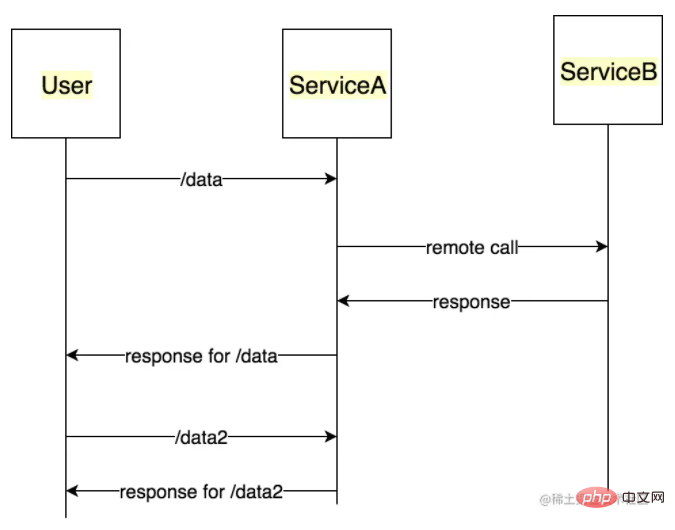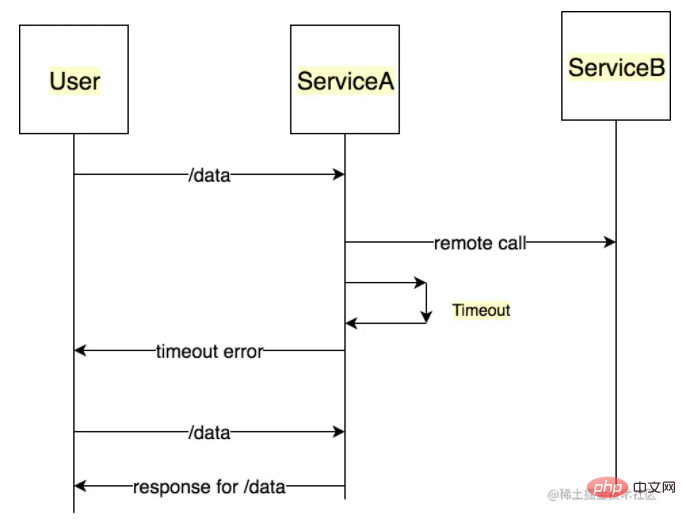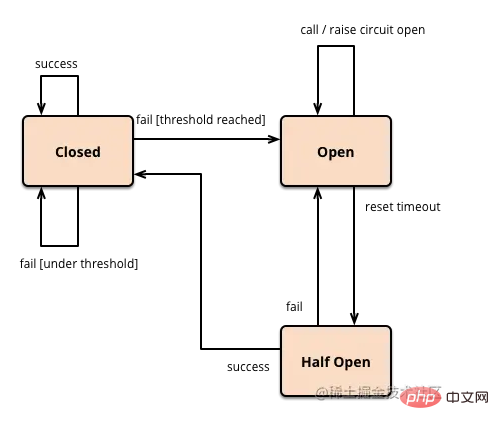An in-depth analysis of the circuit breaker mechanism in Node.js
This article will take you through the circuit breaker mechanism in Node.js, I hope it will be helpful to you!

Problems caused by architecture evolution
When we use the traditional CS architecture, the server blocks requests due to failures and other reasons, which may cause customers to The client's request loses response, resulting in a group of users being unable to obtain services after a period of time. The possible impact of this situation is limited and can be estimated.
However, in a microservice system, your server may depend on several other microservices, and these microservices depend on more other microservices. In this case, a certain service may cause downstream congestion. , which may cause catastrophic consequences on the entire link due to cascading resource consumption in an instant (within seconds), which we call "service collapse". [Recommended learning: "nodejs Tutorial"]


- Fuse mode: As the name suggests, just like household circuits, if the voltage of a line is too high, the fuse will blow to prevent fire. In a system using the circuit breaker mode, if it is found that the upstream service call is slow or there are a large number of timeouts, the call to the service will be directly terminated, information will be returned directly, and resources will be released quickly. The call will not be resumed until the upstream service improves. Isolation mode: Divide calls for different resources or services into several different request pools. Exhaustion of resources in one pool will not affect requests for other resources, preventing a single point. The failure consumes all resources. This is a very traditional disaster recovery design.
- Current limiting mode: Circuit breaker and isolation are both post-processing methods. Current limiting mode can reduce the probability of problems before they occur. The current limiting mode can set a maximum QPS threshold for requests for certain services. Requests that exceed the threshold are returned directly and no longer occupy resources for processing. However, the current limiting mode cannot solve the problem of service collapse, because the collapse is often caused not by the large number of requests, but by the amplification of multiple cascade layers.

- After the number of failures reaches a certain threshold, the circuit breaker will find that the request to ServiceB is invalid. At this time, ServiceA does not need to continue to request ServiceB, but directly returns failure, or Use backup data from other Fallbacks. At this time, the circuit breaker is in the
open circuit state.
- After a period of time, the circuit breaker will start to periodically query whether ServiceB has been restored. At this time, the circuit breaker is in the
half-open state.
- If ServiceB has recovered, the circuit breaker will be placed in the
closed state. At this time, ServiceA will call ServiceB normally and return the result.


- Timeout: how long the request reaches before it causes a failure
- Failure threshold: that is, the circuit breaker triggers an open circuit Before, the number of failures required
Retry timeout: When the circuit breaker is in the open circuit state, how long does it take to retry the request, that is, enter the half-open state
With this knowledge, We can try to create a circuit breaker:
class CircuitBreaker {
constructor(timeout, failureThreshold, retryTimePeriod) {
// We start in a closed state hoping that everything is fine
this.state = 'CLOSED';
// Number of failures we receive from the depended service before we change the state to 'OPEN'
this.failureThreshold = failureThreshold;
// Timeout for the API request.
this.timeout = timeout;
// Time period after which a fresh request be made to the dependent
// service to check if service is up.
this.retryTimePeriod = retryTimePeriod;
this.lastFailureTime = null;
this.failureCount = 0;
}
}Construct the state machine of the circuit breaker:
async call(urlToCall) {
// Determine the current state of the circuit.
this.setState();
switch (this.state) {
case 'OPEN':
// return cached response if no the circuit is in OPEN state
return { data: 'this is stale response' };
// Make the API request if the circuit is not OPEN
case 'HALF-OPEN':
case 'CLOSED':
try {
const response = await axios({
url: urlToCall,
timeout: this.timeout,
method: 'get',
});
// Yay!! the API responded fine. Lets reset everything.
this.reset();
return response;
} catch (err) {
// Uh-oh!! the call still failed. Lets update that in our records.
this.recordFailure();
throw new Error(err);
}
default:
console.log('This state should never be reached');
return 'unexpected state in the state machine';
}
}Supplement the remaining functions:
// reset all the parameters to the initial state when circuit is initialized
reset() {
this.failureCount = 0;
this.lastFailureTime = null;
this.state = 'CLOSED';
}
// Set the current state of our circuit breaker.
setState() {
if (this.failureCount > this.failureThreshold) {
if ((Date.now() - this.lastFailureTime) > this.retryTimePeriod) {
this.state = 'HALF-OPEN';
} else {
this.state = 'OPEN';
}
} else {
this.state = 'CLOSED';
}
}
recordFailure() {
this.failureCount += 1;
this.lastFailureTime = Date.now();
}When using the circuit breaker, you only need to wrap the request Just call it in the Call method in the circuit breaker instance:
... const circuitBreaker = new CircuitBreaker(3000, 5, 2000); const response = await circuitBreaker.call('http://0.0.0.0:8000/flakycall');
Mature Node.js circuit breaker library
Red Hat created a long time ago called Opossum Mature Node.js circuit breaker implementation, the link is here: Opossum. For distributed systems, using this library can greatly improve the fault tolerance of your service and fundamentally solve the problem of service failure.
Original address: https://juejin.cn/post/7019217344601948173
Author: ES2049 / Looking for Singularity
More programming related knowledge , please visit: programming video! !
The above is the detailed content of An in-depth analysis of the circuit breaker mechanism in Node.js. For more information, please follow other related articles on the PHP Chinese website!

Hot AI Tools

Undresser.AI Undress
AI-powered app for creating realistic nude photos

AI Clothes Remover
Online AI tool for removing clothes from photos.

Undress AI Tool
Undress images for free

Clothoff.io
AI clothes remover

AI Hentai Generator
Generate AI Hentai for free.

Hot Article

Hot Tools

Notepad++7.3.1
Easy-to-use and free code editor

SublimeText3 Chinese version
Chinese version, very easy to use

Zend Studio 13.0.1
Powerful PHP integrated development environment

Dreamweaver CS6
Visual web development tools

SublimeText3 Mac version
God-level code editing software (SublimeText3)

Hot Topics
 1386
1386
 52
52
 An article about memory control in Node
Apr 26, 2023 pm 05:37 PM
An article about memory control in Node
Apr 26, 2023 pm 05:37 PM
The Node service built based on non-blocking and event-driven has the advantage of low memory consumption and is very suitable for handling massive network requests. Under the premise of massive requests, issues related to "memory control" need to be considered. 1. V8’s garbage collection mechanism and memory limitations Js is controlled by the garbage collection machine
 Detailed graphic explanation of the memory and GC of the Node V8 engine
Mar 29, 2023 pm 06:02 PM
Detailed graphic explanation of the memory and GC of the Node V8 engine
Mar 29, 2023 pm 06:02 PM
This article will give you an in-depth understanding of the memory and garbage collector (GC) of the NodeJS V8 engine. I hope it will be helpful to you!
 Let's talk about how to choose the best Node.js Docker image?
Dec 13, 2022 pm 08:00 PM
Let's talk about how to choose the best Node.js Docker image?
Dec 13, 2022 pm 08:00 PM
Choosing a Docker image for Node may seem like a trivial matter, but the size and potential vulnerabilities of the image can have a significant impact on your CI/CD process and security. So how do we choose the best Node.js Docker image?
 Let's talk in depth about the File module in Node
Apr 24, 2023 pm 05:49 PM
Let's talk in depth about the File module in Node
Apr 24, 2023 pm 05:49 PM
The file module is an encapsulation of underlying file operations, such as file reading/writing/opening/closing/delete adding, etc. The biggest feature of the file module is that all methods provide two versions of **synchronous** and **asynchronous**, with Methods with the sync suffix are all synchronization methods, and those without are all heterogeneous methods.
 Node.js 19 is officially released, let's talk about its 6 major features!
Nov 16, 2022 pm 08:34 PM
Node.js 19 is officially released, let's talk about its 6 major features!
Nov 16, 2022 pm 08:34 PM
Node 19 has been officially released. This article will give you a detailed explanation of the 6 major features of Node.js 19. I hope it will be helpful to you!
 Let's talk about the GC (garbage collection) mechanism in Node.js
Nov 29, 2022 pm 08:44 PM
Let's talk about the GC (garbage collection) mechanism in Node.js
Nov 29, 2022 pm 08:44 PM
How does Node.js do GC (garbage collection)? The following article will take you through it.
 Let's talk about the event loop in Node
Apr 11, 2023 pm 07:08 PM
Let's talk about the event loop in Node
Apr 11, 2023 pm 07:08 PM
The event loop is a fundamental part of Node.js and enables asynchronous programming by ensuring that the main thread is not blocked. Understanding the event loop is crucial to building efficient applications. The following article will give you an in-depth understanding of the event loop in Node. I hope it will be helpful to you!
 What should I do if node cannot use npm command?
Feb 08, 2023 am 10:09 AM
What should I do if node cannot use npm command?
Feb 08, 2023 am 10:09 AM
The reason why node cannot use the npm command is because the environment variables are not configured correctly. The solution is: 1. Open "System Properties"; 2. Find "Environment Variables" -> "System Variables", and then edit the environment variables; 3. Find the location of nodejs folder; 4. Click "OK".




